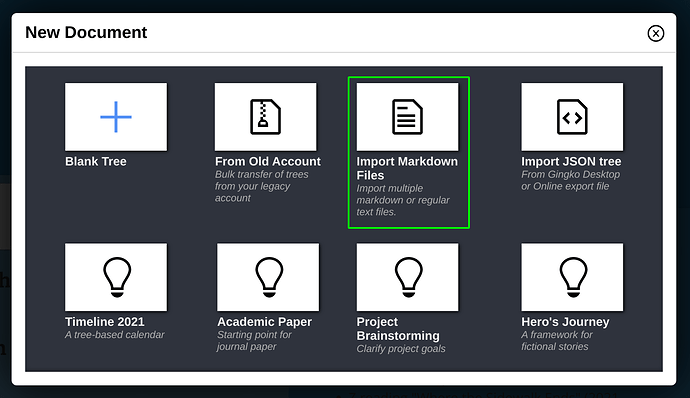Hello everyone. Ginko plugin development started today. I will keep you posted.
Great to hear! Thanks!!!
Is it ready yet? What’s keeping you? 



Thumbs up for this
Thumbs up for this, would be extremely helpful
Hi all, creator of Gingko here (and also, user of Obsidian  ).
).
Just wanted to give you an FYI that I’m working on adding a “Import from Markdown files” feature to Gingko Writer. While it will still be missing the Obsidian goodness of linking etc, it does have some features that are well suited to long-form writing (full version history, for instance).
I imagine the process being:
- Write notes, thoughts, Zettelkasten blocks of content in Obsidian while still in research stage.
- When ready, import selected Obsidian files or folder into Gingko Writer, and work there long-form till you get to first draft.
- Export from Gingko Writer when done.
What do you see as pros/cons of this approach?
I have not used Ginko yet, although (just by looking at it) it seems like a great concept. I do quite a bit of long-form (non-fiction) writing, so may try it out.
For me, the most important question is what kind of export Ginko supports. I usually want my final output in latex – so, if it is too much trouble to get there, I won’t even start. (That’s why I like markdown; less cluttered than latex, but pandoc converts it very well with citations etc.)
I’m doing more and more % of my writing in Obsidian these days, but at the beginning I had a similar approach to what you described, except it was an Obsidian/Scrivener combo. The main problem is that I end up with various versions of texts in various places, which can sometimes be a hassle to track.
I just finished the “Markdown Import” feature of Gingko Writer, and tested it with my own Obsidian notes  .
.
It’s now live on the web version, if you want to try it out : https://app.gingkowriter.com
Gingko uses pandoc under the hood to convert to: MS Word, one plaintext/markdown file, or JSON.
Adding more exports like LaTeX shouldn’t be a problem. (in fact, the old version supports LaTeX input as blocks or inline, and I’d like to add that at some point to the new version too). I wrote my physics PhD in LaTeX, before I built Gingko, so I have fond memories  !
!
Hi, @Adriano and thank you for your work!
What do you see as pros/cons of this approach?
Try to give my opinion, for what it may matter.
THE CONS: I would like to be able to manage all my research/writing process inside Obsidian (being able, for instance, to create and render properly footnotes). The reason: as much precise as my workflow could be, I’m pretty sure I would forget at least a couple of files/notes ti import in Gingko, while if I’m in my vault I can always search for them and include somehow in my writing.
Something like a plug-in would be a great add-on
THE PROS: Gingko is ready-to-use, no waiting list. You like it? You can use it…
Of course it’s just my opinion, based on my experience.
The best news I’ve had in decades! 
Hi @Adriano,
I think your app is great that I can convert my notes in Obsidian into Word in a neat format (e.g., the footnote order). But I still don’t know how to make a block quotation in Gingko Writer. I wonder if there is a way to make it in Gingko Writer?
Thanks
Thanks for the feedback @Hileotech … made me realize that a one-time import isn’t enough. I decided to also try adding drag-and-drop text, so you can keep your Obsidian vault open and easily drag in any text you need/may have forgotten.
It’s still WIP (and not released yet), but here’s me dragging some RPG notes from Obsidian* directly into a Gingko Writer tree structure:

* note: this works with any dragged plain or markdown text, not just from Obsidian.
As inspired by the video, you could name the plugin “Alskdjfahsd.” 
I like this, but there is a gap. This has become a thread on how Obsidian can improve Ginko, and while I don’t oppose, nothing in this workflow makes Obsidian a necessity.
Would it be that Ginko used notefiles as items and metadata for setting the structures like the breadcrumb plugin does, we would have a tool for writing and another tool for mapping the information, which would enter a nice synergy between both.
This does seem interesting. But what’s the difference vs a mind-map?
Maybe the navigation is one difference.
I can see how it could be useful for a visual person like me.
You could have multiple files open in Obsidian and drag and drop from them (the sample itself doesn’t seem that useful I agree). ‘Surfing’ your notes on a particular topic and assembling them in Gingko, however, makes sense to me.
I’d prefer it to be in Obsidian itself - that is, rather than copying and pasting or dragging, using block embeds to ‘build’ a longer paper.
CC: @artem
I think you nailed an aspect here. I commented on the use of files as notes, but it simply could be one file containing the hierarchy that gincko holds, while everything being transclussions to either notes or blocks.
By making the content be listed on a single note, you get the graph to properly link them too!
exactly!
And I should’ve said, but I assume it was obvious, I’d like it to look like Gingko in Obsidian 
great idea! ![]() this really made me laugh!
this really made me laugh!
